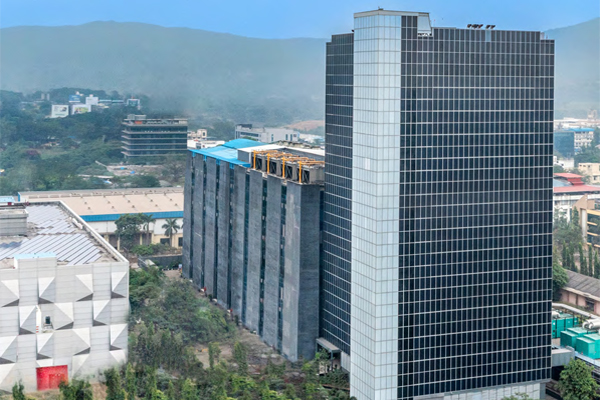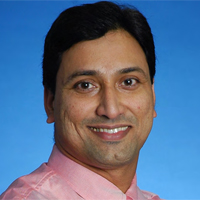The hyperscalers are going to be the key, and India is going to become a 14 billion market size industry with coverage area of a 7.5 million to 15 million square feet.
Data centres are the essential infrastructure that impact the success of digital transformation. A scalable and efficient data centre is crucial in both the construction and operation of stable economy. In recent years, the growing importance of data centre has drawn much attention to related issues including power, sustainability, energy efficiency, real estate, connectivity simplification and service stability. The existing data centres lack the necessary agility for multi-tenant demands in the cloud, creating responsiveness and scalability. On top of it, there are moratorium in many countries in setting up new data centres due to their power guzzling nature. In this story, we present an overview of data centre future from the stake holders and data centre operators. We provide detailed descriptions of several important aspects: the physical architecture, interconnect, automation, sustainability, energy efficiency, etc. We highlight some of the challenges and open issues that should be addressed for future data centre to improve its energy efficiency and increase its throughput while lowering its cost to the customers.
Talking about the industry trend, Paresh Shetty, President Sales, President-Sales, CtrlS Datacenters, said, “5G roll out is what we are looking at eagerly. That would drive different other technologies. In fact, that is the reason why IOT is making a big inroad. With 4G LTE getting rolled out, IOT sensors are deployed everywhere, there is a lot of data which is being collected at the source. If you are going to collect a lot of data, you need to process it, analyse it and also make sure you take intelligent decisions. And that is where AI and ML comes into picture.”
Artificial Intelligence will play a big role with so much of data being collected. With 5G, the Edge Data Centres becoming more and more relevant, data will get processed at the edge and faster decisions can be taken. There is a huge amount of use cases which will be rolled out – be it in the autonomous cars segment, be it in the gaming industry or even in the local content distribution. So, 5G, IOT and AI are all interrelated, and a big transformation is going to happen. All will be blended and that’s where the 5G rollout becomes very important.
Suresh added, “It is going to begin very soon with the government giving all the permissions. But the edge data centre, which we are very relevant to, becomes even more important as 5G rollout starts. When we look at hyperscalers, we will also look at edge data centres and this business – research will show – almost five- or six-times growth will be there on the edge data centres as we start two or three years from now because of the need of the industry”.
“I will take a step back and say that what’s happening today in the industry. If you see we have around 800 – 900 million internet customers and they are downloading 15 GB data every month, which is growing at 20% every year. That is the fastest growth that is anybody seeing anywhere across the world – one of the fastest. Today, what we are seeing is around 60 – 70 % of that content is video and this video needs to be stored, processed, and distributed, which needs a lot of compute and storage capacity. That is fuelling the growth of the data centres. Because it is either being done by the OTTs and the social media companies or it’s happening at the cloud. Both need data centre space. Other space where things are growing is the digital transformation that enterprises are going through,” added, Manoj Paul, Managing Director, Equinix India.
All enterprises – whether it’s small, medium, or large, are going through digital transformation. They are trying to do most of the things on digital platforms rather than on papers. That is what is fuelling big growth in a hybrid solution where they need co-location space at data centres, and they need space also on the cloud. Manoj added, “Cloud is also one of the big customers of our data centres. In India, around 45% of the total co-location space is being consumed by cloud service providers in last two years.”
What is going to happen in future is little different as this trend will continue to grow. AI ML and some of the new technologies are going to bring in a different shift and things are going to happen in two phases. AI has to happen closer to the user – say for instance you walk into a mall, and somebody will process the data quickly and say… ‘hey last time you visited this restaurant and this store, this is your profile, and you will be immediately offered some discount, may be by the same store or event by competitor store or other stores. All that would happen closer to the user. That is what is going to fuel the growth of edge data centres. However, a big part of AI ML may not necessarily need to be closer to the user – say for instance the bank is analysing the spend of a consumer or analysing trends in their branch and trying to find out frauds or the government is trying to find out whether someone has bought a five-crore worth of car and has he paid tax which is equivalent to that or not. That will need huge amount of compute, which can be fifty – sixty hundred milli seconds away from the user and need to have a data centre, which is far from the user but not necessarily need to have a Tier-4 data centre with 99.99 % up time. That is going to fuel data centres which are little away from the city but in big spaces offering more cost competitiveness. So that is what is the trend we are going to see in the future.
“It is going to move towards the edge but before that I think what is more important is: you develop the core. So, what we are seeing right now is the development of the core. And India having longer cycles to deploy data centres, I think the core is going to be the first part. That’s going to get developed to support the compute needs. From that, we will branch out to edge then micro-edges,” said Nikhil Rathi, Founder & CEO, Web Werks. “First part, you will have the core development – that is a two – three years cycle. Two – three years past, you’re going to see edge computing coming into limelight. You want to be closer to the audience. So that content is going to move closer and on top of that, the micro- edge network will shape up. Some kind of cloud repatriation is also happening and what we’re going to see is that these guys are also going to be at the edge using some cloud or their own deployment – depending on what they do. So if it’s a map services company or logistics company, they probably have a virtual machine deployed somewhere in the edge of the micro – edge making sure that tracking of their vehicles is happening properly. It is also sending commands back to the autonomous vehicle. I think that’s going to really shape the future and we’re going to see the core, then edge and then the micro-edge.”
“What is happening today, when 4G has penetrated so deep in the country, we are seeing farmers have started using mobile apps. WhatsApp has become a default app on all mobile phones. More than 80 crores people in India are connected on WhatsApp. This usage of WhatsApp has enabled other apps to come with simple features and transform all the unorganized sectors. So, IOT has entered the agriculture sector,” said, Piyush Somani, Managing Director & Chairman, ESDS Software Solution Limited. “There are so many companies in India who have got patented technologies now. They have brought soil testing sensors. The smart metering initiative is happening right now. More than two million smart meters have already been made live and the government plans to implement 250 million smart meters.”
So, IOT has started penetrating fast into the country and we will see that in next four – five years, majority part of the farming sector would get organized. They would have a lot of technologies. It is not just going to be restricted to IOT but there would be a lot of analytics that is going to happen over there. They are going to use drone-based technology also. So, drone will be doing farm surveys on a regular basis and then the reports would get shared with the farmers. The reports would get shared with the government. The banks are going to consume all that information. The insurance companies are going to see all that information before approving any farm loan. So, there is a massive change that is happening and all of that is going to bring a lot of data in data centres on cloud platforms. At certain locations, let’s say for defence, when there would be drones flying very close to the border areas, there would be humongous data exchange between the drones and the edge data centres as they cannot directly communicate with your master data centre which would be running in Mumbai or Bangalore or Delhi.
Piyush added. “With 250 million smart meters going live, government of India is going to save more than one lakh core rupees a year. As on date, the losses are more than one Lakh crore rupees and in next 3-4 years’ time, it is anticipated that it can increase. So, one can see a massive transformation brought by IOT technology in the utility.”
B.S Rao, Vice President, Marketing, CtrlS Datacenters Ltd, said, “The data has been growing very rapidly. In fact, India today has close to a billion mobile phone users, and we have close to 700 million smart phone users who are consuming internet. My believe is that India’s middle class being 300-400 million and going to touch 700 million, there would be more smart phones penetration and would use more and more social media. There would be data explosion in this country. The question is with data explosion happening with the middle class of one hand half times of United States’ population, whether India can be seen as an emerging global data centre hub?”
As per Piyush India has already started heading towards that direction because majority of that data was unorganized and physical form. It was never stored into a data centre, and it was not digitized at all.
Now all enterprises in India including banks and government organizations -post pandemic – have realised that without digitization they are losing hundreds and lakhs of crore rupees, which we have to short out. Same is in the agriculture sector. What is the government losing? More than three lakh crore rupees per year on the subsidies. Now we have seen that the farm laws have been repelled back, which means the government would lose more money every year. Imagine if all that data coming into the data centres! Just for two million smart meters, we require 30 rack space in a data centre. What would be the requirement for 250 million smart meters? And on top of that you have to run analytics and then you can send sensible information to the consumer like ‘your fridge consumes so much power at this time’, ‘your heater consumes so much power’, etc., which would benefit the customers. Similarly, AI ML requires a humongous amount of compute power and there is a limitation. The chips cannot go below three nanometre gap between the two points in a chip. It means we will not, for at least next four or five years, see major improvement happening in the chip technology. The AI, ML, IOT and blockchain workload will consume humongous amount of power and it has to be there in a data centre.
Bitcoin mining is consuming 20% power of China today. Suddenly they saw a power shortage because of bitcoin. Same thing is going to happen in India when blockchain, may be not bitcoin mining, workloads are going to consume a humongous amount of power.
Piyush added, “I anticipate that by 2033 power consumed by Indian consumers for everything and power consumption by the data centres in India will match.”
The other question is if the Indian data centre industry would be the global benchmark? Nikhil opined, “I think we have a shot at it. We can. I don’t want to confirm that we will because naturally we have larger developed economies ahead of us, which is the size of United States and probably
the whole of Europe. So, we have a lot of catch-up to do versus those guys being developed but on the global map. What also adds is that the use case on the commercial side, which is the government part. You have favourable national policy dynamics also playing over here.”
The data localization bill also making sure that there is a balance of data on the reverse side. So, we’re going to be surplus data – probably going to be throwing out data more than we’re going to pulling data and this will enhance the data centre aspect. Because naturally enterprises are going to run their compute – for example an enterprise wants to integrate with Mastercard, they can do it locally now and processing will happen locally. The enterprise will process it locally. The e-commerce and all of those transactions will also happen locally, which would drive the cloud demand. So, India become a global DC hub, yes, we have a shot at it.
“I think we have a fair shot because of our population, as we develop, as our pockets go deeper, as our consumers spend more and as we consume more data. We are unmatched. We have got all the submarine cables landing in either in Mumbai or Chennai. Remember our neighbors are also going to consume our data. Countries like Sri Lanka, Nepal, Bangladesh, Pakistan, Middle East, Burma, etc. consume a lot of Indian data. So, we are going to push out more data to these places. We could be another Singapore. But more advanced than Singapore as the country has imposed moratorium on more data centres due to climate change issues. So that is also spurring the momentum on favour of India that the next most stable location which also provides that bucket of mercury to support the data centres,” he maintained. “When I say bucket of mercury you take three buckets – water, alcohol, mercury throw the ball in each one of them where it will drown and where it will stay up. So, mercury will support that and that is the ecosystem of our enterprises, our companies, our consumers, which is going to drive us to make sure that the data centres grow.”
In addition, the rural population push has been focusing on LEO Sat (Low Earth Orbit Satellites) and others are reaching out to these fellows, you have the micro-edges over there, which is going to make the things burst.
Echoing Nikhil, Manoj emphasized on the power challenges in the Asia Pacific countries and their challenges. He said, “We need to look at it and a couple of perspectives. One is that: India by itself is becoming a big market. So, the growth in the data centre is getting fuelled by the internal demand from Indian consumers and that is very necessary for any country to become a hub. Let us not talk about becoming a global hub, let us start focusing on becoming a South Asia hub and I think that itself would be a big achievement for us.”
There are many changes around developed countries in the APAC. Singapore has put a moratorium on any new data centres, Hong Kong is going through its own challenges along with power issues. In last two three months, the power tariff in Singapore, Japan and even in Hong Kong have gone through the roof. So, India is well poised with power tariffs being quite stable in the last three four years. In fact, India is better against Singapore and Hong Kong and quite competitive against other countries. So, India can cater to at least the nearby South Asian countries. And whatever expansion Singapore is seeing can happen to India and some large players are now looking at Chennai being the next extension of Singapore because of its proximity.
He added, “I keep giving this example that there’s a big social media company who is investing in building a billion-dollar data centre in Singapore. And that company has 500 to 600 million users in India. So, naturally, if we get all the things right including ease of doing business, good quality infrastructure, good power, etc., I am sure, next time when they want to expand, they should be planning to expand into India catering to other markets not the other way down. So India’s burgeoning demand and improvement in infrastructure, improvement in ease of doing business as most of the state governments have rolled out new policies to enable or help data centres, it will go hand in hand to enable India become the Asia Pacific hub, South Asia hub and then maybe at some point of time World Hub, because India has become an IT hub any which way.”
IT hubs in Hyderabad, Chennai and Bangalore caters to all over the world, which was unthinkable 20 years back.
The other moot point is if the future data centre would be robotised? Will the robotic and intelligent processes replace the humans to make sure they’re far more efficient and far more productive and far more oriented towards customers?
Explaining the question, Piyush said that it has already started happening. ESDS has recently launched its Bangalore data centre and the power control panels used in the DC is designed in such a way that they do not require electrical engineers on site except the team would come once in a month and evaluate. There are bigger players in the market who would bring technology from offshore, and they would have started implementing much better technologies now. In case of the software’s also, there are various software now which are available for data centre automation. IOT
based sensors are installed in the data centre. The temperature is continuously sensed across all the layers of the racks, which are there in your data centre and based on that the fans are getting automatically adjusted. So, the system is taking care of it – where and how much cooling need to be provided. The intelligence system is helping you to improve your Power Usage Effectiveness (PUE). You do not need to unnecessarily put the entire data centre into 20 degrees Celsius.
Piyush added, “We have already implemented that technology. I am pretty sure that a lot of other players are implementing similar technology and maybe in next three to four years I anticipate that in the data centres you may not require the data centre management staff, or you may not require the electrician because that part is very easy to automate and the command and control centre would sit at one place and they would just keep on monitoring this.”
With the heat generated there’s a lot of carbon footprint, it’s going to be a battle between data centres and sustainability. Where is the battle heading?
Nikhil said, “I think the data centres are definitely power guzzlers, but we have our automation. We are partnered with Iron Mountain and Iron Mountain is one of the first companies to sign COP26. Everybody and all our data centre friends also are moving towards the green and sustainability targets that have been set globally. In terms of our automation that is all there. You have web controls and systems which protect energy but you’re also making sure that what you’re
consuming must come more from green fuel and less from the fossil fuel. We do have our limitations in India because of the regulatory over here, which doesn’t allow you to consume more than a limit – I think the max you can go up to I think 55 % of using green energy or renewable energy because of generally regulatory frameworks and because they want you to consume more coal.”
As far as the customer is concerned, they should ask their data centre partner to let them know how the sustainability part is taken care of in terms of how the carbon footprint is neutralized. There
are even talks about using hydrogen – based fuel to run the data centre. But yes, we have got solar, wind, etc. If the regulatory framework opens up in India, everybody will move towards that.
Equinix is also 100% committed to use of renewable power and has already set a target for the company. Manoj said, “We are the leaders in some of the markets. In India, we have some way to go but then sustainability is in two parts – one is trying to ensure that we use more and more of renewable power but at the same time try to consume less power. For that both customers and data centre service providers need to go hand in hand. The customers need to stop asking for 24-degree cooling whereas today 27- degree standard is very much acceptable. They should start agreeing for 27- degrees. The hardware vendors need to build equipment which can sustain 27 even 28 – 29 degree.”
He added, “I don’t think it’s too much of a rocket science or it needs too much of extra effort to make it so durable; then each degree brings in another 10% of efficiency. That is one area where we all need to work together. Second is of course time to see how much energy we can get from renewable power. India from that perspective is well placed. We have already around 100 gigawatts of renewable power which is going to touch 200 next few years. Of course, the government has a target of getting 450 gigawatt of renewed power and the data centre industry is only going to need one and a half or two gigawatt by 2024. It is just a fraction of the total solar or renewable power that we have in the country.”
So, India is very well placed and that goes again to say that India can become a hub only also on this point but what is also more important is the whole feeling that data centres are data guzzlers. To which the service providers should be telling back to the whole society that they are enabling them to save diesels and petrol. Manoj maintained, “We as data centre service provider need to educate the whole ecosystem around us or the social fabric that ‘don’t see us enemies, don’t go out with placards that stop data centres, they are overusing the energy’.”
B. S Rao said, “As data centre companies, we are powering the economies, we are powering the lives of students, lives of patients and what not, so I think data centres are the great initiatives against its perception. But yes, from energy perspective there is a challenge.”
Speaking about the trends in energy efficiency because there is a growing density per rack, Paresh said, “Data centres are going in strength. Though they are power guzzlers at the same time Data centres are saving a lot of power, otherwise on-premises data centres would have done better. Energy efficiency or energy conservation becomes extremely important and we at CtrlS are putting a lot of focus towards it. Energy efficiency in data centre is measured in PUE, which is total core compute power versus the total power that we use.”
In fact, CtrlS has got almost 80 innovations on energy efficiencies. The company has brought it close to almost 1.35 which is industry’s best and thy are using energy efficient equipments, which are energy star certified. Starting from creating optimized the C racks for air conditioning to optimizing the chiller plants by making hot and cool island containment zones, the company has invested a lot. The other one is motion sensors are being set so that the light is not being used as per requirement. All the lights are generally LED. So, a lot of optimizations is happening at CtrlS. The company follows around 20 – 30 parameters to make sure the PUE is reduced to the lowest and still work is going on. Paresh maintained, “It is a continuous process because whatever energy we save we are contributing back”
Piyush said, “We need to think of the future. I have read some policies, which have come out from one of the states in India and they have started thinking of the future. They know that the data centres will require a lot of power in the future. They are allowing data centres to enter contracts directly with power generation companies like those who are into solar power, renewed power, etc. We can go directly into a contract with them and the state would charge a nominal fee for the transmission through their discoms. We actually need to come up together and put pressure on the government that looking at the 100 gigawatts of power requirement of the data centre, you should not start hating the data centre.”
As per him there are data centres in Bangalore, which are very close to the lakes and data centres in
Mumbai, which are very close to the sea and the heat exchange of the data centres can happen with the water bodies. He added, “In Nasik we are doing that. We have seven lakh litres of water in our campus. We exchange the heat of the data centre with the water body. During the daytime, the temperature of that water body will not even increase by 1 degree Celsius and during night-time, it exchanges that heat with the space, which is at minus 22 degree Celsius. So, all the heat which the water body stores during the daytime is actually given back to the space at the night time. Through that the data centres can achieve 20 – 25 % of efficiency in their power consumption which is required for cooling.”
There can be many other methods also. One of the places in Maharashtra what they are doing is during is in night-time, they are lifting water because government of India has got surplus power at the night – time and daytime they are generating power through the hydropower station. So, something similar can be done when we are surplus with solar power to lift water in the lakes.
We have a lot of cloud players and social media players consuming a lot of data. The future is all about how we can minimize latency and make sure that the data is accessed in a quick manner. Are we moving towards hyperscale data centres, do interconnects have a role to play?
To this Nikhil said, “Yes, we are moving towards hyperscalers. We had the five Horsemen which were
consuming most of the hyperscale capacity. But what we’re seeing is even cloud repatriation happening and some of our enterprises and BFSI segment customers are also poised to become hyperscale capable customers. We are going to see that as a boom and because of that interconnection is the key to all of this. Data centre is built on multiple pillars – land, building, cooling, manpower and most importantly– connectivity. If you don’t have connectivity what’s the data in the data centre? So, interconnection plays an extremely important role. What we see happening is multiple IXes have come in. And these IXes have grown a lot of data peering, andhave reduced latency. We’ve seen a few exchanges in our facility as well and the others as well. those are going to reduce latency to one hop away. So, the application is a hop away from the other place, which is going to be working on that application or what that data exchange is going to actually happen.”
Nikhil maintained, “In terms of hyperscalers, the interconnection definitely does play a big role and I see interconnection basically becoming more and more pervasive. Along with the enterprises, we already have government connecting in. With all of that the latency reduces.” It is like a snowball effect. Interconnection drives lower latency, improves application, improves consumption, and increases data centres. So, it is snowball after snowball effect and hyperscalers are on top of that and it is an avalanche after that.
Paresh maintained, “Absolutely. We’ve seen that in the interconnections and hyperscale is going to become the key moving forward and the entire acceleration started during the pandemic with all the on-premises data centre moving towards the centralized data centres. Initially the data centres were trying to be modular, trying to become few megawatts of data centres. But once you get into the hyperscalers, you get the advantage of real estate, power and you bring in a lot of efficiencies, which you can pass to the customer. It is basically a wholesale versus a retail kind of a thin.”
So, the hyperscalers are going to be the key and India is going to become from a 7 billion to a 14 billion market size with coverage area of a 7.5 million to 15 million square feet. Once this kind of growth is coming in, it’s going to be the hyperscale to play a key role. This has happened in multiple countries – be it in Thailand, Vietnam, etc. We have seen them started off with small megawatts but now they grew up with the kind of demand growing in. And in India, the way government is supporting, and the way digital transformation is going to take off, the data is going to be very high and you have to have big scale to provide to the consumers of India – be it government or the enterprises.
There are 3-4 billion dollar on-premise data centres in India and they’re likely to move to the hyperscale so whether the interconnects and the hyperscale data centres be the reality?
Manoj added, “Specially in Equinix we have 10,000 enterprise customers across the globe in our 233 data centres. We see the interconnect with each other and with the carriers in a big way, which is not so much happening in India, but we believe it is soon going to happen. Today, for instance HDFC bank connects to two – three carriers. Everybody has to connect to them through those two – three carriers. Very soon you would like to see them connect to the internet exchange so that they have the redundancy but at the same time suppose you are working from home and you are connected to a cable operator, you go a single hop and connect to the HDFC server rather than going through a lot many. Similarly, businesses need to interconnect with each other. Today if you go to Flipkart and do something then it has to push you back to a bank site and the back site pushes you back and if you are buying something from Zomato, Zomato has to connect to the restaurant and find out what is available then come back to you take you to a bank site.”
He concluded, “Enterprises need to connect with each other also and that is what we are seeing across the world where our 10 000 customers who are on our platform depend on the Equinix platform to interconnect with each other so that they can be more efficient more flexible and expectedly this is going to happen in India also.”
We have not seen the interconnection being leveraged by enterprises and the government and that is going to fuel further growth within data centres. And when enterprises go to select a data centre, they’re not going to know whether you have cooling, whether you’re Tier-4, etc., they will only ask if a data centre can connect with multiple cloud service providers at the flick of a button and if they can go to the internet and upgrade interconnection to the cloud from one gig to ten gig in a matter of few minutes.
Finally…
India is going to go to the Edge computing, all the customers would find edge data centre in Tier -2 and Tier-3 cities. Will India become the global data centre hub, perhaps in the long run. But in the short term we will become a regional hub. Third, we will get robotized and intelligent data centres would bring efficiencies to the customer. We will be nice to the planet by being sustainable. B.S Rao, concluded, “I think green data centres is the future. Energy efficiency is the key aspect and interconnects would play a very important role to make sure customers have a good experience while they work on an application and hyperscale data centres are the necessity.”
Read More News: https://www.enterpriseitworld.com/
Watch CIOs Tech Perspectives: https://ciotv.live/
Read IT Partner News on: https://www.smechannels.com/









